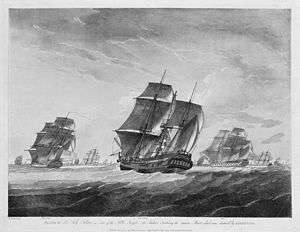Lady Juliana (1777 ship)
 The Lady Juliana in tow of the Pallas Frigate. The Sailors Fishing the main Mast which was shatter'd by Lightning by Robert Dodd | |
| History | |
|---|---|
| Britain | |
| Name: | Lady Juliana |
| Builder: | Stephenson & co., Whitby[1] |
| Launched: | 1777 |
| Fate: | Last listed in Lloyd's Register in 1829.[2] |
| General characteristics | |
| Class and type: | Barque |
| Tons burthen: | 401, or 500[1] (bm) |
| Length: | 110 feet |
| Beam: | 40 feet |
| Sail plan: | 3 masts |
| Complement: | 2 decks |
| Armament: | 20 × 6-pounder guns[1] |
Lady Juliana (also known as the Lady Julian)[3] was launched at Whitby in 1777. She transported convicts in 1789 from Britain to Australia. She was the first convict ship to arrive at Port Jackson in New South Wales after the First Fleet, and so some consider her part of the Second Fleet, but some do not. A transportation register can be seen at The UK National Archives.[4]
The British government chartered her to transport female convicts.[5] Her master was Thomas Edgar, who had sailed with James Cook on his last voyage. The surgeon was Richard Alley, who was apparently competent by the standards of the day, but made little attempt to maintain discipline. After a delay of six months the Lady Juliana left Plymouth on 29 July 1789, and arrived at Port Jackson on 6 June 1790. She took 309 days to reach Port Jackson, one of the slowest journeys made by a convict ship. One reason was that she called at Tenerife and St Jago, and spent forty-five days at Rio de Janeiro, and nineteen days at the Cape of Good Hope. She carried 226 female convicts, five of whom died during the journey.
Her steward, John Nicol, wrote an account of the voyage. He gives a fascinating account of the voyage and the convicts. Most of these were London prostitutes, but there were some hardened criminals - thieves, receivers of stolen goods, shoplifters - among them.
Lady Juliana gained the reputation for being a floating brothel. Nicol recalled that "when we were fairly out to sea, every man on board took a wife from among the convicts, they nothing loath." At the ports of call seamen from other ships were freely entertained, and the officers made no attempt to suppress this licentious activity. No provision had been made to set the convicts to any productive work during the voyage, and they were reported to be noisy and unruly, with a fondness for liquor and for fighting amongst themselves.[6]
The low death rate during the voyage was due to Edgar and Alley's care. Rations were properly issued, the vessel kept clean and fumigated, the women were given free access to the deck, and supplies of fresh food were obtained at the ports of call. This treatment was in sharp contrast to that meted out on the infamous Second Fleet.
When Lady Juliana arrived at Port Jackson she was the first vessel to arrive there since the First Fleet's arrival almost two and a half years before. In the grip of starvation, with HMS Sirius having wrecked at Norfolk Island, Judge Advocate David Collins was mortified at the arrival of "a cargo so unnecessary and so unprofitable as 222 females, instead of a cargo of provisions". Lieutenant Ralph Clark was more blunt, lamenting the arrival of still more "damned whores". The ship carried letters bringing the first news of events in Europe to the settlement since the First Fleet had sailed in May 1787. Two weeks later the storeship Justinian arrived, followed a week later by the three ships of the Second Fleet with their shameful cargo of starved and maltreated convicts.
After repairs to her strained timbers, Lady Juliana sailed for China on 25 July 1790 to take on a cargo of tea for the East India Company. She arrived in England on 26 October 1791.
Notable convicts aboard Lady Juliana
- Mary Wade - Mary was transported as the youngest convict at 11 years of age, and at the time of her death at age 82, had over 300 living descendants.[7]
- Elizabeth Steel - Elizabeth is historically recorded as the first deaf Australian. Her headstone was discovered in 1991.
- Mary Pardoe - Mary gave birth to Ann (fathered by Edward Scott, sailor aboard Lady Juliana) in March 1790 while making the journey to Australia. This child was the youngest person on board Lady Juliana when she arrived at Port Jackson.[8][9]
References
- 1 2 3 Lloyd's Register (1778), seq. no. 32.
- ↑ Lloyd's Register (1829), seq. no. L55.
- ↑ Wheeler, Sara (17 March 2002). "Ship of Floozies". nytimes.com. Retrieved 10 November 2014.
- ↑ "TNA ref. HO 11/1/15 - Transportation register of convicts bound for New South Wales on the convict ship Lady Juliana, June 1789"
- ↑ Australia Her Story, by Kylie Tennant
- ↑ Damousi, Joy (April 1995). "Chaos and order: Gender, space and sexuality on female convict ships". Australian Historical Studies. Routledge. 26 (104): 351. Retrieved 28 October 2014. (subscription required (help)).
- ↑ The Second Fleet Transports - Lady Juliana
- ↑ Australian Royalty
- ↑ Australian English Genealogy
Further reading
- Bateson, Charles, The Convict Ships, 1787-1868, Sydney, Library of Australian History, 1983. ISBN 0-908120-51-6
- Nicol, John, John Nicol, Mariner: Life and Adventures 1776-1801, Melbourne, Text Publishing, 1997. ISBN 0-87113-755-0
- Rees, Sian, The Floating Brothel, Sydney, Hodder, 2001. ISBN 978-0-7336-2463-6
External links
- Voyage of the Courtesans Documentary produced by the PBS Series Secrets of the Dead
- "Convicts to Australia - Lady Juliana 1790"
- The Lady Julian
- ABC Television Documentary ' The Floating Brothel'
- The Lady Julian Poem
- The Second Fleet Transports - Lady Juliana
- Australian Maritime History - Wooden Tall ships